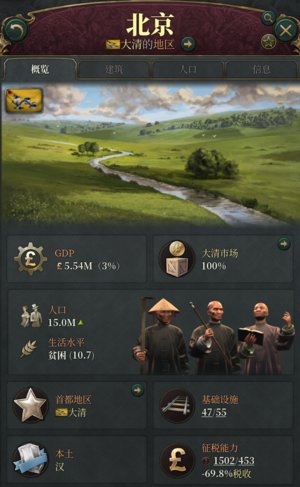无编辑摘要 |
|||
| 第1行: | 第1行: | ||
{{Version|pre-release}} | {{Version|pre-release}} | ||
{{hatnote| | {{hatnote| 对于跨海运输货物的花费,参见[[ 商船]] 。}} | ||
[[File:UI state overview.png|thumb|地区面板上的基础设施和市场接入度|链接=Special:FilePath/UI_state_overview.png]] | [[File:UI state overview.png|thumb|地区面板上的基础设施和市场接入度|链接=Special:FilePath/UI_state_overview.png]] | ||
{{图标|Infrastructure|21px}} | {{图标|Infrastructure|21px}} 基础设施模拟了陆路运输货物的成本,并为支持大规模工业化创造了必要的基础。 | ||
基础设施模拟了陆路运输货物的成本,并为支持大规模工业化创造了必要的基础。 | |||
为了实现一个地区的工业化,不仅仅要在那建造重工业并且让人们能够在其中工作。玩家同样需要确保工业有足够的基础设施去支撑它们。 | 为了实现一个地区的工业化,不仅仅要在那建造重工业并且让人们能够在其中工作。玩家同样需要确保工业有足够的基础设施去支撑它们。 | ||
这与许多其它机制密切相关,例如市场接入度,补给,移民等。 | |||
== 基础设施资源 == | |||
基础设施有众多的来源,并且被众多因素所修正。 | 基础设施有众多的来源,并且被众多因素所修正。 | ||
=== 地区 | === 地区 修正 === | ||
游戏中所有的地区都基于所属国家拥有的科技拥有至少一些基础设施,同时这取决于州是否被整合(举个例子,殖民地比已整合地区拥有的基础设施少)。 | |||
地理通过地区修正来表现,同时在基础设施方面发挥着重要作用。地区修正是赋予某一特定地区的奖励或减益,代表特定 的 地理特征、气候等。 地区 特征具 有 多种影响,但最常见 的 是影响特定资源的生产或提供/修改 基础设施 。 例 如 ,拥有 重要河流 的 地区在 基础设施 方面得到了很大的奖励,这使它们成为早期工业化的绝佳候选地。 | |||
=== 人口 === | |||
一些 基础设施 值同样可以通过 地区 中的人口规模获得------当解锁了 特定的 社会学科技 的 时 候。 相关科技处于从城镇化开始 的 社会学科技树上 。基础设施 获 得 数量 的 详情可以通过在每个地区 的 信息面板上通过 {{图标|Infrastructure|21px}} 基础设施查看,来自人口规模的基础设施在其中被称为“'' 来自人口'' ”。它是基于居住在该州的个人( 包括受抚养人口) 的数量,使用的公式为: | |||
<math display="inline">\text{state infrastructure from Pops} = \frac{\text{population}\cdot \text{Infrastructure from Population (technology modifier)}}{\text{10000}}</math> | <math display="inline">\text{state infrastructure from Pops} = \frac{\text{population}\cdot \text{Infrastructure from Population (technology modifier)}}{\text{10000}}</math> | ||
一些基础设施 | 几乎所有国家(包括许多松散的国家)在游戏开始时至少研究了一种相关科技,因此有 一些基础设施 。注意, 地区 的UI工具提示 中 显示 的 精确值是被四舍五入到一个小数点后 的 位置 。 | ||
=== 短期 的 替代品 === | |||
有一些短期 的 替代方案,例如使用权威力{{图标|authority|21px}} 激活道路养护法令,以确保民众不会让道路失修或变得不安全 , 但这些选项对于大 规模 工业化 来 说远远不够 。 | |||
=== 铁路 === | |||
在游戏过程中,一个国家基础设施最关键的方面是其铁路网的规模。 | |||
=== 铁路 | |||
在游戏过程中,一个国家基础设施最关键的方面是其铁路网的规模。 | |||
铁路是生产运力{{图标|transportation|21px}}的建筑,是卖给大众的无形商品,但它们也是国家基础设施的主要来源。为了发挥作用,铁路必须能够找到回归市场资本的途径,或者为市场资本找到一个出口。实际上,这意味着任何一条铁路所能提供的基础设施数量,都不超过连接其与市场资本的最佳邻近铁路所能提供的基础设施数量。 | 铁路是生产运力{{图标|transportation|21px}}的建筑,是卖给大众的无形商品,但它们也是国家基础设施的主要来源。为了发挥作用,铁路必须能够找到回归市场资本的途径,或者为市场资本找到一个出口。实际上,这意味着任何一条铁路所能提供的基础设施数量,都不超过连接其与市场资本的最佳邻近铁路所能提供的基础设施数量。 | ||
这涉及到各种各样的成本,因为提供基础设施的铁路既需要人口来运营,也需要获得煤炭和发动机等 | 这涉及到各种各样的成本,因为提供基础设施的铁路既需要人口来运营,也需要获得煤炭和发动机等 产品 。当然,随着柴油火车和电力等发明的出现,铁路的效率也在不断提高, 只 需要更少级别的铁路就能支撑一定数量的建筑。 | ||
== | === 港口 === | ||
当使用任何非锚地生产方式时,港口提供运输船和一些基础设施。这在研究火车之前的早期游戏中很有用,可以让发达沿海国家获得一些额外的基础设施,但与火车相比,提供的基础设施数量很低,而且这不是港口的主要目的,所以不具有成本效益,特别是在铁路建设之后。 | |||
== 基础设施的使用 == | |||
一个地区的基础设施使用是由该地区的建筑物类型和它们的等级决定的。一般来说,越是城市化和专业化的建筑,每级使用的基础设施就越多。例如,化学工业(重工业建筑)将比同等等级的黑麦农场建筑多使用几倍的基础设施。 | |||
'''注''':自给农场和城市中心不使用基础设施。前者是因为其生产几乎全部用于国内,后者是因为其提供的基础设施抵消了其所需的基础设施。 | |||
基础设施的目前情况由每个地区具有的两个不同值表示:已有基础设施数和基础设施已使用数。这两个有价值的数据决定了地区的的市场接入度。只要该地区的已有基础设施数大于或等于基础设施使用数,那么该地区会良好运行并保持100%的市场接入度,但如果基础设施使用率开始超过可用的基础设施,市场接入度将减少,数量与 | == 市场接入度 == | ||
基础设施的目前情况由每个地区具有的两个不同值表示:已有基础设施数和基础设施已使用数。这两个有价值的数据决定了地区的的市场接入度。只要该地区的已有基础设施数大于或等于基础设施使用数,那么该地区会良好运行并保持100%的市场接入度,但如果基础设施使用率开始超过可用的基础设施,市场接入度将减少,数量与未得到满足的需求成正比。例如,如果一个地区的基础设施是45,而使用率是90,那么它的市场接入度将只有50%。 | |||
低市场接入度意味着国家无法将其当地市场完全融入全国市场,这可能导致当地商品供应过剩或不足导致不利的价格状况。这种不平衡是双向的。例如,如果有一个拥有完善市场准入的铁矿开采地区,那么所有州的铁价格都是一样的。如果铁矿石开采地区的市场接入度减少,其余地区铁矿石的市场价格将因供应不足而上涨,而铁矿石开采地区的当地价格将因供应过剩而下跌。 | 低市场接入度意味着国家无法将其当地市场完全融入全国市场,这可能导致当地商品供应过剩或不足导致不利的价格状况。这种不平衡是双向的。例如,如果有一个拥有完善市场准入的铁矿开采地区,那么所有州的铁价格都是一样的。如果铁矿石开采地区的市场接入度减少,其余地区铁矿石的市场价格将因供应不足而上涨,而铁矿石开采地区的当地价格将因供应过剩而下跌。 | ||
| 第83行: | 第49行: | ||
良好的市场接入度对于复杂商品的生产至关重要。无论是在国内市场上从另一个地区采购特定的投入产品(或通过从外国进口),还是为了让足够多的人买得起这些产品,都需要良好的市场接入度。 | 良好的市场接入度对于复杂商品的生产至关重要。无论是在国内市场上从另一个地区采购特定的投入产品(或通过从外国进口),还是为了让足够多的人买得起这些产品,都需要良好的市场接入度。 | ||
== 引用 | == 引用 == | ||
<references/> | <references/> | ||
[[Category:游戏概念]] | [[Category:游戏概念]] | ||
[[en:Infrastructure]] | [[en:Infrastructure]] | ||
2023年2月23日 (四) 22:27的版本
- 对于跨海运输货物的花费,参见商船。
![]() 基础设施模拟了陆路运输货物的成本,并为支持大规模工业化创造了必要的基础。
基础设施模拟了陆路运输货物的成本,并为支持大规模工业化创造了必要的基础。
为了实现一个地区的工业化,不仅仅要在那建造重工业并且让人们能够在其中工作。玩家同样需要确保工业有足够的基础设施去支撑它们。
这与许多其它机制密切相关,例如市场接入度,补给,移民等。
基础设施资源
基础设施有众多的来源,并且被众多因素所修正。
地区修正
游戏中所有的地区都基于所属国家拥有的科技拥有至少一些基础设施,同时这取决于州是否被整合(举个例子,殖民地比已整合地区拥有的基础设施少)。
地理通过地区修正来表现,同时在基础设施方面发挥着重要作用。地区修正是赋予某一特定地区的奖励或减益,代表特定的地理特征、气候等。地区特征具有多种影响,但最常见的是影响特定资源的生产或提供/修改基础设施。例如,拥有重要河流的地区在基础设施方面得到了很大的奖励,这使它们成为早期工业化的绝佳候选地。
人口
一些基础设施值同样可以通过地区中的人口规模获得------当解锁了特定的社会学科技的时候。相关科技处于从城镇化开始的社会学科技树上。基础设施获得数量的详情可以通过在每个地区的信息面板上通过 ![]() 基础设施查看,来自人口规模的基础设施在其中被称为“来自人口”。它是基于居住在该州的个人(包括受抚养人口)的数量,使用的公式为:
基础设施查看,来自人口规模的基础设施在其中被称为“来自人口”。它是基于居住在该州的个人(包括受抚养人口)的数量,使用的公式为:
[math]\displaystyle{ \text{state infrastructure from Pops} = \frac{\text{population}\cdot \text{Infrastructure from Population (technology modifier)}}{\text{10000}} }[/math]
几乎所有国家(包括许多松散的国家)在游戏开始时至少研究了一种相关科技,因此有一些基础设施。注意,地区的UI工具提示中显示的精确值是被四舍五入到一个小数点后的位置。
短期的替代品
有一些短期的替代方案,例如使用权威力![]() 激活道路养护法令,以确保民众不会让道路失修或变得不安全,但这些选项对于大规模工业化来说远远不够。
激活道路养护法令,以确保民众不会让道路失修或变得不安全,但这些选项对于大规模工业化来说远远不够。
铁路
在游戏过程中,一个国家基础设施最关键的方面是其铁路网的规模。
铁路是生产运力![]() 的建筑,是卖给大众的无形商品,但它们也是国家基础设施的主要来源。为了发挥作用,铁路必须能够找到回归市场资本的途径,或者为市场资本找到一个出口。实际上,这意味着任何一条铁路所能提供的基础设施数量,都不超过连接其与市场资本的最佳邻近铁路所能提供的基础设施数量。
的建筑,是卖给大众的无形商品,但它们也是国家基础设施的主要来源。为了发挥作用,铁路必须能够找到回归市场资本的途径,或者为市场资本找到一个出口。实际上,这意味着任何一条铁路所能提供的基础设施数量,都不超过连接其与市场资本的最佳邻近铁路所能提供的基础设施数量。
这涉及到各种各样的成本,因为提供基础设施的铁路既需要人口来运营,也需要获得煤炭和发动机等产品。当然,随着柴油火车和电力等发明的出现,铁路的效率也在不断提高,只需要更少级别的铁路就能支撑一定数量的建筑。
港口
当使用任何非锚地生产方式时,港口提供运输船和一些基础设施。这在研究火车之前的早期游戏中很有用,可以让发达沿海国家获得一些额外的基础设施,但与火车相比,提供的基础设施数量很低,而且这不是港口的主要目的,所以不具有成本效益,特别是在铁路建设之后。
基础设施的使用
一个地区的基础设施使用是由该地区的建筑物类型和它们的等级决定的。一般来说,越是城市化和专业化的建筑,每级使用的基础设施就越多。例如,化学工业(重工业建筑)将比同等等级的黑麦农场建筑多使用几倍的基础设施。
注:自给农场和城市中心不使用基础设施。前者是因为其生产几乎全部用于国内,后者是因为其提供的基础设施抵消了其所需的基础设施。
市场接入度
基础设施的目前情况由每个地区具有的两个不同值表示:已有基础设施数和基础设施已使用数。这两个有价值的数据决定了地区的的市场接入度。只要该地区的已有基础设施数大于或等于基础设施使用数,那么该地区会良好运行并保持100%的市场接入度,但如果基础设施使用率开始超过可用的基础设施,市场接入度将减少,数量与未得到满足的需求成正比。例如,如果一个地区的基础设施是45,而使用率是90,那么它的市场接入度将只有50%。
低市场接入度意味着国家无法将其当地市场完全融入全国市场,这可能导致当地商品供应过剩或不足导致不利的价格状况。这种不平衡是双向的。例如,如果有一个拥有完善市场准入的铁矿开采地区,那么所有州的铁价格都是一样的。如果铁矿石开采地区的市场接入度减少,其余地区铁矿石的市场价格将因供应不足而上涨,而铁矿石开采地区的当地价格将因供应过剩而下跌。
良好的市场接入度对于复杂商品的生产至关重要。无论是在国内市场上从另一个地区采购特定的投入产品(或通过从外国进口),还是为了让足够多的人买得起这些产品,都需要良好的市场接入度。
